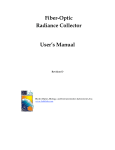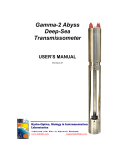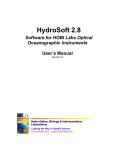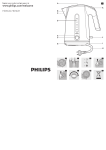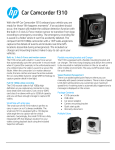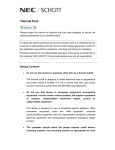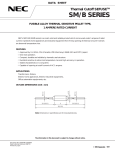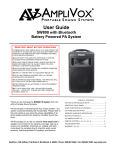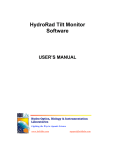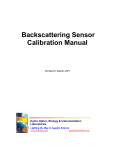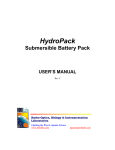Download Scalar Collector Manual D - Hobi Instrument Services
Transcript
Scalar Irradiance Fiber-Optic Light Collector User’s Manual Revision D: October 2009 Hydro-Optics, Biology, and Instrumentation Laboratories, Inc. www.hobilabs.com REVISIONS: D—October 2009: Updates regarding mounting. C—October 2007: Add warning against cleaning with alcohol. B—July 2007: Start of revision tracking 2 DESCRIPTION The HOBI Labs Scalar Irradiance Collector, shown in Figure 1, gathers light uniformly from all directions (except for the portion of the sphere that is blocked by the black base and neck), and transmits it to a fiber-optic SMA connector in its base. When mated with an appropriate fiber-optic cable, the light collector is fully waterproof and can be immersed to depths of 200 meters. • Globe diameter: 6.4 cm (2.5 in.) • Length: 11 cm (4.4 in.) not including mating connector • Usable wavelength range: 380 to 1000 nm PRECAUTIONS AND MAINTENANCE • Handle the globe carefully. It may break if dropped or jarred. • Upon removing the collector from salt water, before removing fiber-optic cables, rinse thoroughly with fresh water. • Do not clean with acetone, pure alcohol, or other harsh solvents. Purified water is best, with soap if necessary. • Do not allow any moisture into the SMA connector. To avoid this, dry the collector and SMA connector before detaching a cable from it. • Protect the SMA connector with a cap whenever it is not attached to a cable. • When attaching an SMA connector, use only your fingers to tighten it. Tools may apply excessive force to the threads. • Thoroughly clean the exterior of the collector before storing it. Figure 1. Scalar irradiance collector MOUNTING The circular base of the collector has four threaded holes, as shown in Figure 2, that can be used to attach it to a bracket or structure. These holes are tapped with U.S. 440 threads, arranged in a circle 1.06” (26.9 mm) in diameter. ½-inch screws, appropriate for mounting to brackets roughly 0.1 to 0.3” (1.5 to 6 mm) thick, are supplied with the 3 unit. Ensure that any screws you use thread no more than 0.4” (10 mm) into the base. Longer screws could protrude from the other side of the base and damage the globe. The base also has a groove for a 2-014 o-ring. The o-ring is not required for most applications, but can be used when the collector is attached to a watertight vessel or cable assembly such as the armored cables supplied by HOBI Labs. Additional holes in the base are Figure 2. Collector base, bottom view also intended for use in HOBI cable assemblies. WATERPROOFING To provide a water seal, place a 3mm-internal diameter, 1mm wide o-ring (supplied) around the end of the cable’s SMA ferrule, as shown in the photograph below, before screwing it into place. For best results, tighten the connection by holding the end of the cable stationary rotating the collector. This help to work the o-ring into its groove without pinching it. The connector should be hand-tightened (rather than using a wrench) to avoid stripping the plastic threads. Note that when you disconnect the SMA, the oring will usually remain on the SMA ferrule. 4 Figure 3. Inserting SMA connector with o-ring in place WATERPROOFING OF FIBER-OPTIC CABLES Most off-the-shelf cables are constructed with a waterproof outer jacket, but this does not guarantee a watertight assembly. The SMA connector on the end of the cable must also be properly sealed at the time of manufacture. Water entry into a cable will not necessarily cause problems, but it is best avoided, and users should be aware of the following considerations. Most high-quality cables are sealed, but if not, the most likely entry point for water is where the cable’s outer jacket enters the fiber optic connector. This is normally covered by a strain-relief “boot” as shown below. This boot may or may not form a seal by itself. Figure 4. SMA termination with boot Figure 5. SMA termination with boot removed. Arrow indicates possible water entry point. The arrow in Figure 5 marks the point where the jacket enters the connector. At some point inside the connector the jacket ends, at which point it must be sealed. In high-quality commercial cables the connector is typically filled with epoxy, encapsulating the jacket and providing an adequate seal. However since the seal is internal the only way to be sure is to consult the manufacturer. If in doubt, you can provide extra protection by sealing the ends of the boot, or even encapsulating it entirely, with a waterproof adhesive such as the silicone caulking that is used for sealing fish tanks. 5





